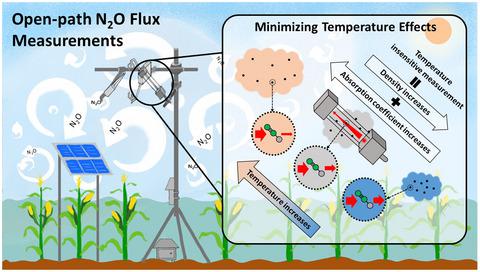当前位置:
X-MOL 学术
›
Glob. Change Biol.
›
论文详情
Our official English website, www.x-mol.net, welcomes your
feedback! (Note: you will need to create a separate account there.)
A new open-path eddy covariance method for nitrous oxide and other trace gases that minimizes temperature corrections
Global Change Biology ( IF 10.8 ) Pub Date : 2021-11-10 , DOI: 10.1111/gcb.15986 Da Pan 1, 2 , Ilya Gelfand 3, 4, 5 , Lei Tao 1, 2 , Michael Abraha 3, 4, 6 , Kang Sun 7, 8 , Xuehui Guo 1, 2 , Jiquan Chen 3, 6 , G Philip Robertson 3, 4, 9 , Mark A Zondlo 1, 2
Global Change Biology ( IF 10.8 ) Pub Date : 2021-11-10 , DOI: 10.1111/gcb.15986 Da Pan 1, 2 , Ilya Gelfand 3, 4, 5 , Lei Tao 1, 2 , Michael Abraha 3, 4, 6 , Kang Sun 7, 8 , Xuehui Guo 1, 2 , Jiquan Chen 3, 6 , G Philip Robertson 3, 4, 9 , Mark A Zondlo 1, 2
Affiliation

|
Low-power, open-path gas sensors enable eddy covariance (EC) flux measurements in remote areas without line power. However, open-path flux measurements are sensitive to fluctuations in air temperature, pressure, and humidity. Laser-based, open-path sensors with the needed sensitivity for trace gases like methane (CH4) and nitrous oxide (N2O) are impacted by additional spectroscopic effects. Corrections for these effects, especially those related to temperature fluctuations, often exceed the flux of gases, leading to large uncertainties in the associated fluxes. For example, the density and spectroscopic corrections arising from temperature fluctuations can be one or two orders of magnitude greater than background N2O fluxes. Consequently, measuring background fluxes with laser-based, open-path sensors is extremely challenging, particularly for N2O and gases with similar high-precision requirements. We demonstrate a new laser-based, open-path N2O sensor and a general approach applicable to other gases that minimizes temperature-related corrections for EC flux measurements. The method identifies absorption lines with spectroscopic effects in the opposite direction of density effects from temperature and, thus, density and spectroscopic effects nearly cancel one another. The new open-path N2O sensor was tested at a corn (Zea mays L.) field in Southwestern Michigan, United States. The sensor had an optimal precision of 0.1 ppbv at 10 Hz and power consumption of 50 W. Field trials showed that temperature-related corrections were 6% of density corrections, reducing EC random errors by 20-fold compared to previously examined lines. Measured open-path N2O EC fluxes showed excellent agreement with those made with static chambers (m = 1.0 ± 0.3; r2 = .96). More generally, we identified absorption lines for CO2 and CH4 flux measurements that can reduce the temperature-related corrections by 10–100 times compared to existing open-path sensors. The proposed method provides a new direction for future open-path sensors, facilitating the expansion of accurate EC flux measurements.
中文翻译:

一种用于一氧化二氮和其他痕量气体的新开路涡流协方差方法,可最大限度地减少温度校正
低功耗、开路气体传感器可在没有线路电源的偏远地区进行涡流协方差 (EC) 通量测量。然而,开路通量测量对气温、压力和湿度的波动很敏感。对甲烷 (CH 4 ) 和一氧化二氮 (N 2 O)等痕量气体具有所需灵敏度的基于激光的开路传感器受到额外光谱效应的影响。对这些影响的校正,尤其是与温度波动有关的校正,通常会超过气体通量,导致相关通量存在很大的不确定性。例如,由温度波动引起的密度和光谱校正可能比背景 N 2大一个或两个数量级O 通量。因此,使用基于激光的开路传感器测量背景通量极具挑战性,特别是对于 N 2 O 和具有类似高精度要求的气体。我们展示了一种新的基于激光的开路 N 2 O 传感器和一种适用于其他气体的通用方法,该方法可最大限度地减少 EC 通量测量的温度相关校正。该方法识别具有与温度的密度效应相反方向的光谱效应的吸收线,因此,密度和光谱效应几乎相互抵消。新型开路 N 2 O 传感器在玉米(Zea maysL.) 位于美国密歇根州西南部的油田。该传感器在 10 Hz 时的最佳精度为 0.1 ppbv,功耗为 50 W。现场试验表明,与温度相关的校正是密度校正的 6%,与之前检查的线相比,EC 随机误差减少了 20 倍。测得的开路 N 2 O EC 通量与静态室的通量非常一致(m = 1.0 ± 0.3;r 2 = .96)。更一般地,我们确定了 CO 2和 CH 4的吸收线 与现有的开路传感器相比,通量测量可以将与温度相关的校正减少 10-100 倍。所提出的方法为未来的开路传感器提供了一个新的方向,促进了精确 EC 通量测量的扩展。
更新日期:2022-01-16
中文翻译:

一种用于一氧化二氮和其他痕量气体的新开路涡流协方差方法,可最大限度地减少温度校正
低功耗、开路气体传感器可在没有线路电源的偏远地区进行涡流协方差 (EC) 通量测量。然而,开路通量测量对气温、压力和湿度的波动很敏感。对甲烷 (CH 4 ) 和一氧化二氮 (N 2 O)等痕量气体具有所需灵敏度的基于激光的开路传感器受到额外光谱效应的影响。对这些影响的校正,尤其是与温度波动有关的校正,通常会超过气体通量,导致相关通量存在很大的不确定性。例如,由温度波动引起的密度和光谱校正可能比背景 N 2大一个或两个数量级O 通量。因此,使用基于激光的开路传感器测量背景通量极具挑战性,特别是对于 N 2 O 和具有类似高精度要求的气体。我们展示了一种新的基于激光的开路 N 2 O 传感器和一种适用于其他气体的通用方法,该方法可最大限度地减少 EC 通量测量的温度相关校正。该方法识别具有与温度的密度效应相反方向的光谱效应的吸收线,因此,密度和光谱效应几乎相互抵消。新型开路 N 2 O 传感器在玉米(Zea maysL.) 位于美国密歇根州西南部的油田。该传感器在 10 Hz 时的最佳精度为 0.1 ppbv,功耗为 50 W。现场试验表明,与温度相关的校正是密度校正的 6%,与之前检查的线相比,EC 随机误差减少了 20 倍。测得的开路 N 2 O EC 通量与静态室的通量非常一致(m = 1.0 ± 0.3;r 2 = .96)。更一般地,我们确定了 CO 2和 CH 4的吸收线 与现有的开路传感器相比,通量测量可以将与温度相关的校正减少 10-100 倍。所提出的方法为未来的开路传感器提供了一个新的方向,促进了精确 EC 通量测量的扩展。











































 京公网安备 11010802027423号
京公网安备 11010802027423号